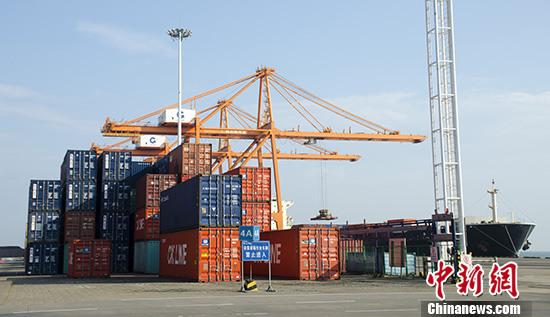(Economic Observation) RCEP highlights four highlights
China News Service, Beijing, November 16th, title: RCEP highlights four highlights
China News Agency reporter Li Xiaoyu
The "Regional Comprehensive Economic Partnership Agreement" (RCEP) was finally signed after 8 years of negotiations.
Scholars here believe that as the world's largest free trade agreement, RCEP has four highlights.
Data map: A freighter berths at the container terminal in the Qinzhou Free Trade Port Area in Guangxi.
Photo by China News Agency reporter Zhai Liqiang
More than 90% of goods trade in the region finally achieve zero tariffs
According to the agreement, after the RCEP takes effect, more than 90% of the goods trade in the region will eventually achieve zero tariffs, and the tax will be reduced to zero immediately and to zero within 10 years.
Zhang Jianping, director of the Regional Economic Cooperation Center of the Institute of International Trade and Economic Cooperation of the Ministry of Commerce, said in an interview with a reporter from China News Agency that the zero-tariff ratio of goods trade in large-scale free trade agreements can reach 85%, which is a high level.
Taking into account the huge gap in the economic development level and scale of the 15 RCEP member countries, it is "hard-won" that the zero-tariff ratio of goods trade can reach more than 90%.
"More than 90% is a fairly high level, indicating that the parties to the RCEP are ambitious about the quality of the agreement." said Gao Lingyun, a researcher at the Institute of World Economics and Politics, Chinese Academy of Social Sciences.
The head of the International Department of the Ministry of Commerce of China stated that with the implementation of uniform rules such as rules of origin, customs procedures, inspection and quarantine, and technical standards, the elimination of the superposition of tariff and non-tariff barriers will gradually release the trade creation effect of RCEP and significantly reduce the regional Trade costs and product prices enhance the competitiveness of products in the region, benefiting all companies and consumers.
Leading openness of service trade
In terms of trade in services, 7 members including Japan, South Korea, Australia, Singapore, Brunei, Malaysia, and Indonesia adopt negative list commitments, while the remaining 8 members including China adopt positive list commitments, which will be converted into negative list within 6 years after the agreement takes effect. List.
The person in charge of the International Department of the Ministry of Commerce stated that in terms of openness, all 15 parties have made openness commitments higher than their respective "10+1" free trade agreements.
China’s service trade opening commitment has reached the highest level of existing free trade agreements. The number of service departments promised is based on the approximately 100 departments promised by China’s accession to the WTO. 22 new services including R&D, management consulting, manufacturing-related services, and air transportation have been added. Departments, and increased the level of commitments in 37 departments including finance, law, construction, and shipping.
In recent years, service trade has become the most dynamic part of global trade, playing an increasingly important role in economic and trade development.
RCEP enhances the openness of service trade and will promote the further expansion of service trade among members.
The principle of regional accumulation expands preferential coverage
RCEP uses the regional accumulation principle in this region, that is, the value components of the origin of products can be accumulated in the region composed of 15 member states, and the value components from any party of RCEP will be taken into account to increase the utilization rate of the agreement.
According to this principle, according to the rules of origin of the previous bilateral free trade agreements between members, it cannot be counted as a product of a certain country's origin. After the accumulation of regional value, it may be recognized as RCEP regional origin and enjoy RCEP preferential tariffs.
Gao Lingyun said that this is of great significance for accelerating the integration of industrial chains and supply chains in the Asia-Pacific region and consolidating China's dominant position in the global industrial chain and supply chain structure.
Investment transparency is greatly improved
In terms of investment, the 15 member states of RCEP have adopted a negative list approach to make high-level openness commitments for investment in the five non-service sectors of manufacturing, agriculture, forestry, fishery, and mining.
In addition to relevant rules on investment liberalization, RCEP also contains investment protection clauses such as fair and equitable treatment, expropriation, foreign exchange transfer, and loss compensation, as well as investment facilitation clauses such as dispute prevention and coordination and settlement of foreign complaints.
The parties agreed to discuss an investment dispute settlement mechanism between investors and countries within two years after the RCEP agreement came into effect.
Zhao Jinping, former director of the Foreign Economic Research Department of the Development Research Center of the State Council of China, said that investment is the driving force behind the adjustment of the industrial chain and supply chain.
With the expansion of enterprise investment, production will inevitably accelerate the layout of the region, which will further increase the regional logistics demand.
(Finish)

